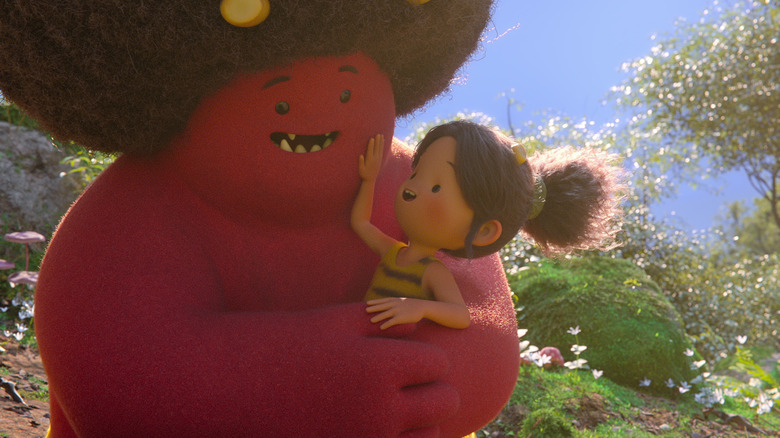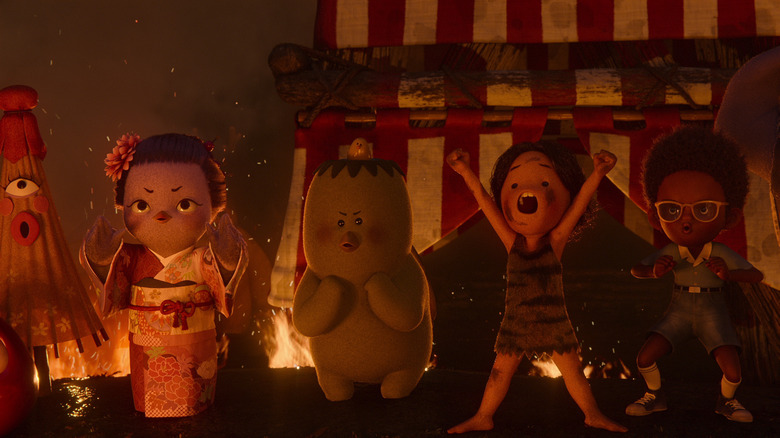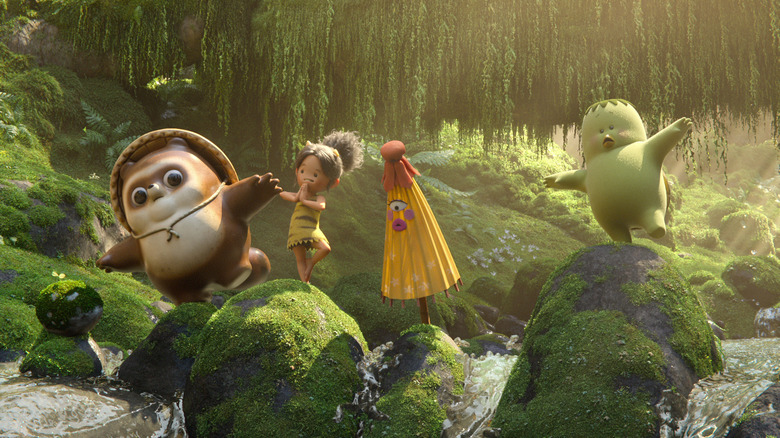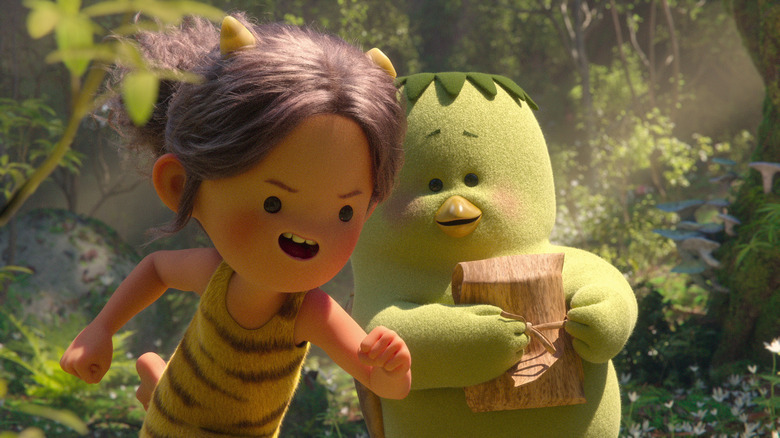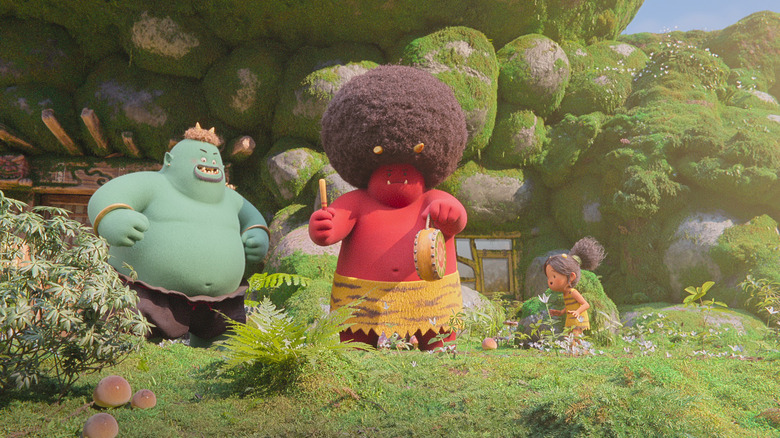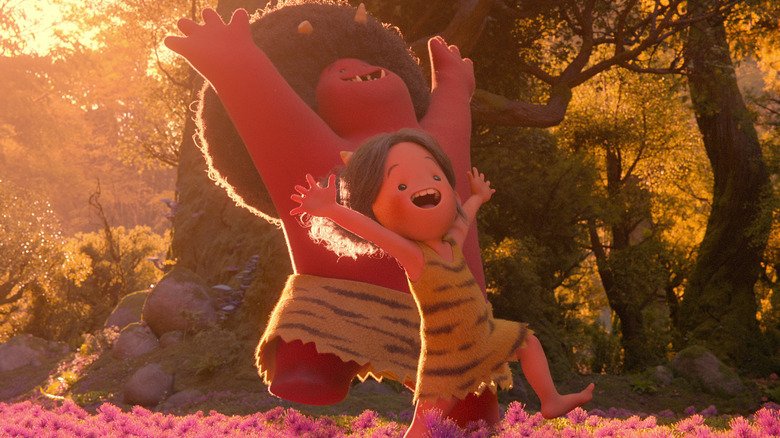Oni: Thunder God's Tale Director On Craig Robinson's Charm And Making CG Look Like Stop Motion [Exclusive Interview]
Stop-motion animation is one of the oldest, most difficult, and most stunning animation techniques there is. But as beautiful as stop motion projects are, the amount of effort, time, and money required to produce them means we see fewer and fewer projects using this technique. That being said, 2022 has been an outstanding year for stop motion, with titles like Phil Tippett's "Mad God," Netflix's "The House" anthology, Henry Selick's "Wendell & Wild," and Guillermo del Toro's "Pinocchio" showing how versatile, malleable, and exciting the art form can be.
Then there's "Oni: Thunder God's Tale," a new Netflix mini series that looks like it was made with the same tools as any of the films listed above, but was actually made entirely with CGI. The show is set in the world of Japanese folklore, filled with gods and monsters of all shapes and forms — from the thunder god to vegetable and umbrella spirits. It focuses on Onari, an odd girl who is a bit of an outcast in her society and whose unique powers have not blossomed yet. But she will have to find her powers soon, because the town is preparing for the fateful arrival of demon-like creatures they call Oni. Soon, Onari will go through a journey of self discovery as she realizes the true meaning of the word "monster."
/Film had the chance to talk to "Oni: Thunder God's Tale" director Daisuke "Dice" Tsutsumi about the show, translating Japanese mythology to a global audience, giving personality and life to abstract ideas, and how the team made CG animation look so incredibly tactile.
'It's human nature, even to this day, to fear people we don't understand or a culture that we don't know'
Note: This interview has been lightly edited for clarity and brevity.
Where did the idea for the show come from?
So in Japanese folklore, "Oni" is the word to describe the villains. It's always the monsters or the devils. If you look at almost every single Japanese folklore hero story, Oni's the villain in the story. But I read this really interesting theory. It's actually quite famous. There's a historical theory that Oni might have been a description of foreigners who lived in Japan years ago, like in ancient times. There were a small group of people who didn't look like the Japanese locals, the villagers. People might have been scared and then called them Oni and that became the villains in the story that they passed on through generations.
I really felt that theory was interesting, because it's human nature, even to this day, to fear people we don't understand or a culture that we don't know, or the appearance of others that you may not be familiar with. I felt the concept of Oni can be told with their own spin in the world inspired by Japanese folklore, but as you saw it, the story is completely original. Because I wanted to tell the story to connect with the people of today, because the concept of Oni, the fear of others that you are not familiar with, does exist, even to this day.
There's also a very interesting bit in the show when we meet a kid who is called "gaijin" by his peers, a derogatory term for foreigners, which ties back to your take on the Oni.
In the beginning, it was purely just my personal connection to that idea. I grew up in Japan and I migrated to United States close to 30 years ago, and I lived through in this country and I worked in the business of Hollywood as a foreigner, as a minority, and I have my personal experience of how people see others that they may not be familiar with.
Even extending to my own child. My son is 10 years old. He is a Japanese-American living in Berkeley, California. How is he going to face where he belongs or who he identifies with? What he identifies with? And I felt like the story can be created to inspire people who have that similar experience. And personally, selfishly, I want my son to take this story and then be inspired and find a way to embrace himself uniquely. It doesn't have to be anything that others might define, but you can be who you are.
I thought it would be really interesting to just tell this story through almost the opposite perspective. "What is Oni?" is really a constant question in the story, and we are in the world of Japanese monsters and gods and they are also afraid of things they don't know.
'It'd be really fun to see an umbrella talking'
A fun aspect of the show is seeing all these different spirits and creatures have unique personalities. How was it to give life to relatively abstract concepts and mythological creatures?
This is really the fun part of the unique culture of Japanese folklore. We have this belief "Yaoyorozu no Kami," which means "eight million gods" in Japanese. And basically what it is, Japanese people, especially traditionally, believe in Animism, where we believe in souls and gods and spirit living in every single thing around you, whether it's in nature or animals or even objects. And I love the philosophy where you basically respect everything around you. It's not just about humans that is what you care for. You care for everything around you.
I thought it'd be really fun to see an umbrella talking and maybe vegetables having their lives and just a normal, regular classroom and monsters and cat and octopus. That is kind of like the world of Japanese folklore. Although the story is completely made up — it's not like there's a folklore story. But that concept of eight million gods, I wanted to bring in and hopefully audiences can still relate to our characters, because we still try to write our characters as if they are humans. They have a humanity inside.
And how was the process of designing the characters? Because, of course, they don't exactly look like their classical illustrations.
So definitely Tonko House, our studio, loves to create characters that are simple. Our motto for the design is "Can we describe a lot through very simple elements?" You notice a lot of our characters have only got eyes, and you've got to understand, in the western world of animation, even Japanese anime, eyes are supposed to be big. You have to have big eyes.
But it's just our philosophy. Like, "No, we could still convey emotion, if it's done right, and we can create human stories that people can relate to without having to have these big eyes that we are most used to in the western animation world." Same thing with the body shapes. You know can see, compared to the illustration of Kapa and then our Kapa, all the details are gone. Just simple. Simple just blobby, little plushie thing.
'We tried our best to make sure that our CG doesn't look computery'
The show looks absolutely stunning, but I understand it is not actually stop motion, but CG?
In the beginning, this project was a fully animated and stop motion project. So it was supposed to be a hundred percent stop motion. We even made a pilot, like three sequences in stop motion, working with a Japanese stop motion studio called Dorf. And we loved it. All of us are such huge fans of stop motion. I never had experience in stop motion, but I always dreamed of making stop-motion animation.
Unfortunately and fortunately, the story had gotten bigger and the story got deeper and very serious towards the end. It just got kind of epic, and that's when we decided to make a switch to CG, because a lot of us at Tonko House come from Pixar and CG is something we're very familiar with. Not to say that we didn't want to challenge ourselves with the new medium, but this story became too big for us to experiment with something we didn't know too well. So we switched to CG, and Oni is 100% CG. Everything you saw on screen was CG.
But we tried to capture the feeling that we were able to achieve with the stop motion tests we did. Because that look and the [tactile] feeling and [the sense that] you can almost immerse yourself in the world, we wanted to capture. So we tried our best to make sure that our CG doesn't look computery, like it feels something that you can touch and you can feel.
That is quite amazing, because even in the movements, it feels like physical puppets. Like the way you play with the frame rate.
Yeah, so same thing. When we did the pilot test, three sequences with stop motion, even the movement was so charming. There's something about the stop motion with the imperfection of limited frame rate just felt like it was enough to convey all the character emotions, all the fun, all the life that we wanted to have. So we definitely tried to experiment with that CG, but it wasn't just reducing the frames.
Also, we looked at Japanese anime from the '80s. This is a Japanese story and the animation studios we partnered with to make the production were all Japanese studios and we didn't want to do what is standard for Pixar and Disney. We wanted to do something we could only make, specific to this group, and the Japanese anime from the '80s had a similar — budget was tight, the schedule was tight, but then there was a lot of talent.
Hayao Miyazaki, before he did feature film, he did television animation in very limited frames. Some on twos or sometimes on threes, but they still beautifully made it work, and still, their focus was on the poses. Their focus on the silhouette and poses were very strong. And we tried our best to capture that in CG, because our animators are rooted in Japanese anime themselves.
'We tried to be as naturalistic as possible'
The show is made by a very international crew. Was that important to you?
This is a very important thing for us, because as I told you earlier, the concept of Oni being the description of the, I guess, outsiders, right? People who don't live in the territory. It was important, and I think everybody has that story. Even though we worked with Japanese studios in Japan, there are a lot of foreign artists who live in Japan on this project. We had freelancers from Europe. We had definitely a lot of people from America, and that's important, because they can relate to the story of Onari, when you find out that you are not necessarily one of the groups that you thought you were part of.
And then, going back to the animation, I was very interested in the way the show captures the environment, how it uses lighting and space. It doesn't feel staged.
That is what we try to do. The environment is very rich, but it's not over-designed. I think that's really the key. So our production designer, Robert Kondo [and the rest of the team], they tried their best to simplify, but not over-design, because we wanted the audience to feel it's believable. It's something that you can be in it. It's not staged. It's not like a movie set. I wanted people to feel that they're actually in the forest in Japan.
And lighting is something I specialize in. Before I became director, at a place like Pixar, I was a lighting art director and I always knew that lighting can be a really powerful tool to tell a story. But what's really important, even for "Oni," was the same thing. Let the light do the job. Don't over-design. And I think there are some shots in "Oni," mainly because of the schedule and budget we were constrained with, but at the same time, there are a lot of shots where the face is dark and light is hitting on the belly. That's something that the big studios [would say], "Oh, no, no, no. You got to make sure the light should be on the face."
We couldn't afford to do a lot of [our non-traditional technique], but I loved it, because that's how we live in the world we live in. Not over-designed, over-manicured, but let it be just beautiful. Let the nature be the guide. We tried to be as naturalistic as possible so that our focus is more on the feeling and air, instead of human craft that's too visible to the audience.
'Craig was incredible'
Finally, can you talk about Naridon? Especially creating a character that never talks, and crafting that performance with the animators and Craig Robinson?
Craig was incredible. Naridon is a very strange character. He's one of the main characters, as you said, who doesn't have dialogue. And in the very, very beginning, everybody was concerned. I had to convince everybody, "No, we have two main characters. One is this energetic, talkative girl, and then the other one can't communicate. He has his own language. He doesn't have dialogue." And everybody's like, "What?"
But I felt it was so powerful when, somehow, if we can achieve their love and trust in each other can be created, not through words, but through truly how they kind of interact with each other dynamically — like physically or even emotionally. And Craig Robinson, you can imagine, we recorded Craig hours and hours of, "Nom, nom, nom, nom." I was just so afraid he would just get mad. Like, "What am I doing?" But, truthfully, he is one of a kind actor. If we could bring emotion through just one word, I couldn't believe it. It was so beautiful.
And then, of course, our animators did a fantastic job conveying Naridon's internal struggle. The scar he carries, the guilt he carries with him, all through pantomime. So really, it was incredible work that our team did to achieve such a strange, unique character.
"Oni: Thunder God's Tale" is now streaming on Netflix.
